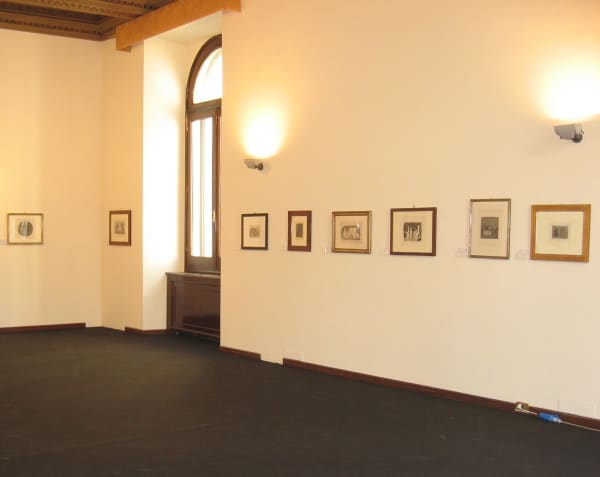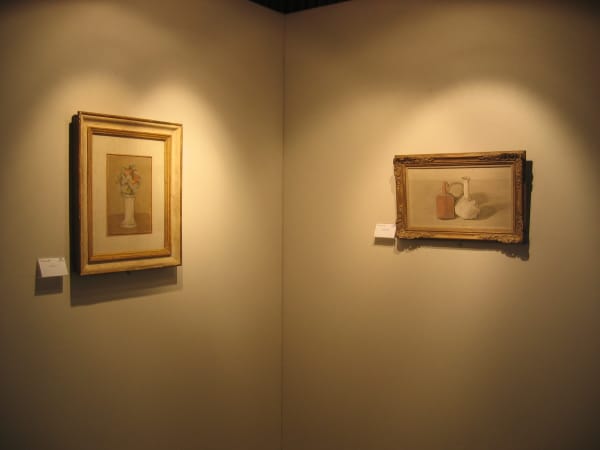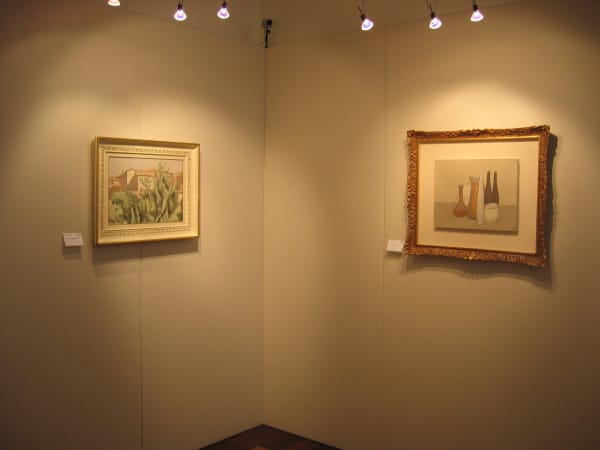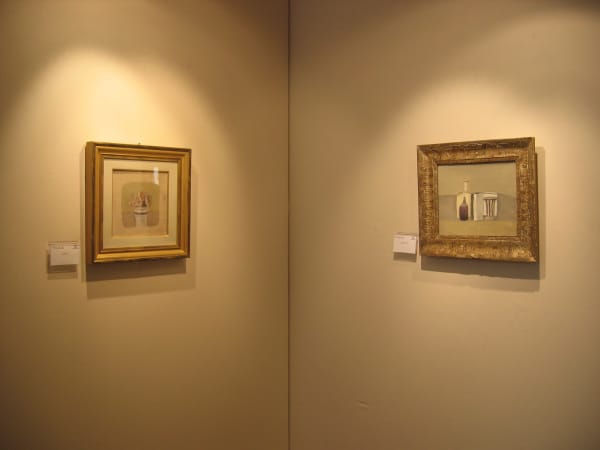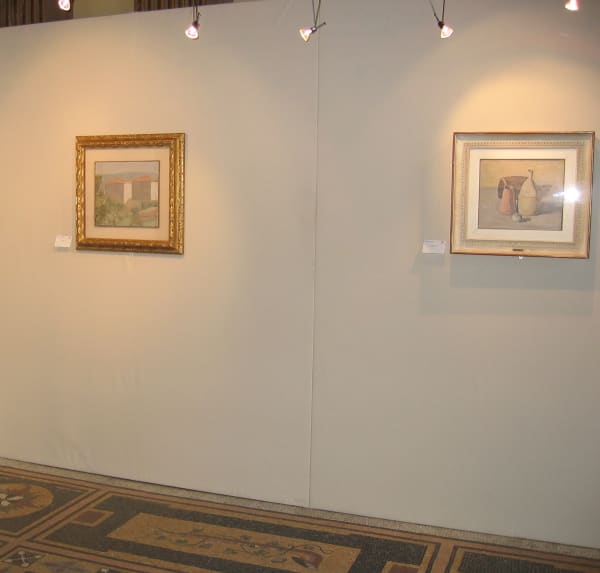Palazzo Wedekind, Rome
Giorgio Morandi as seen by Cesare Brandi
When I met Morandi in 1933, he was living in Via Fondazza. The other day, in Bologna, I returned—almost between one train and the next one—to greet Morandi. He still lives in Via Fondazza. This is not an insignificant detail for Morandi. Living in Bologna and residing in Via Fondazza. A few years ago, it seemed that he would have to leave that house, whose only modest beauty, the view of a kind of garden that is also a kind of orchard, would now suffer a harmful blow, a cruel reduction, or even a total absorption into a new building. For Morandi, this is a great pain: moreover, it is the alteration of an urban landscape that is very dear to him, even though no one else, other than him, would have been able to extract a spider from a hole there. He sighs at every change, but then the landscape turns out the same. He sighs for the tree that has grown, for the tree that has been cut, for the freshly painted shutter, for the new door, for the new little balcony. He sighs, but the next year, when we visit him, we find that the television antennas have also become part of the landscape on the easel. In those skies that are uniquely his, Bolognese skies, of course, but Morandi's Bologna, we see a slight wrinkle, a barely visible scar; yet it is the television antenna that has merged with the sky, like the dust on his bottles. Morandi doesn’t boast about it: but how could he refuse this new element to his usual landscape, intrusive as it may be, but real?
Indeed, there is no house clearer than Morandi’s. Entering that modest house is like drinking from a mountain spring, like sitting on a flowered meadow, like passing by a country oven. It’s a house where it seems that a star has stopped, one of those stars, as Palazzeschi wrote in a distant poem, which you don’t know whether even a great city has. In this rented house, everything is modest, but everything is clean, everything shines with the brightness that comes from a history, like good manners, a history of care and renunciations. And then there are the flowers.
This is another passion of Morandi. In winter, when the remaining plants from the garden below must be brought inside due to the cold, the landing outside Morandi's door appears as a staircase of plants that peacefully winter there in the air, almost as if outside, in the drafts of the stairs. And those pots, so lovingly cared for by Morandi’s sisters, seem to watch you and make you hesitate before you dare cross the threshold. The fuchsias, in particular: those fuchsias always intimidated me. However, I don’t pay them too much attention and step over the threshold. Morandi’s dear sister is there, waiting with a smile...
But I wouldn’t have told you anything about Morandi if I hadn’t at least mentioned Grizzana... For someone coming from Florence by the fast line, Grizzana is a station you barely notice, at the bottom of the valley, with the yellowish, barren hills rising. That’s how I saw it, and it didn’t inspire me to get to know it better when I met Morandi. Moreover, it’s not as though Morandi's landscapes depicted particularly pleasant aspects. Back then, in complete serenity, I had designated Grizzana as one of Italy's most delightful places.
For Morandi, however, it is a place of the imagination, the meeting point of the daily main road with those airy paths that lead to painting, to his painting. Thus, Grizzana, a remote village in the Tuscan-Emilian Apennines, has become a location that cannot be ignored by those who care about modern painting: much like Arles for Van Gogh or L'Estaque for Cézanne...
When Morandi received the Grand Prize at the São Paulo Biennale in 1957, the award ceremony was held in Rome at the Palazzo Pamphili at the Brazilian Embassy. Morandi, who didn’t like speaking in public, even in front of a large audience, asked me to deliver a speech on his behalf to the Ambassador. The only words Morandi said were: “Thank you, Mr. Ambassador, many thanks.”
...Of Monet's cathedrals, burned or incinerated, we remember the flow of colors, so harmonious and merged in the air’s nourishment; and the dawn or sunset that could still light up the wash of the Rhine Maidens and the guttural cries of the Valkyries. But in these Morandi landscapes, taken at different moments, it doesn’t matter whether it’s dawn or sunset: they relate to a story that doesn’t unfold within the span of a day. Monet’s reproduction of light effects, with all its harmonic adjustments, betrayed the optical transposition in which his brilliant mind got lost. It is pleasing to recognize in Morandi's countryside a gaze that doesn’t merely capture the shifting arrangement of shadows and lights: because they become not a harmonious cloak, varied on a line of song, but the very inflection of the song itself.
I remember a hedge along the road (it must have been tangled with dusty bonfires, so softened now), the façade of the Villa with its thin poplars: and recovering these things as if they belonged to a memory, and feeling them with an emotion that doesn’t connect to any memory, is the first step to embarking on Morandi’s painting. Which, now, in the serene image it offers of itself, untouched by controversies, chastised and therefore pure, given the time in which it rises; this is how we would describe it—beneficent and almost celestial.
There are painters for whom engraving is a secondary path, almost a vacation from painting: others, for whom engraving becomes the very core of their artistic form. If Rembrandt was the prince of the latter, Morandi belongs to this group. From his earliest engravings—a 1913 landscape proves this—painting and engraving are posed with the same stylistic problems, with the same drastic rigor; and it must be understood that neither painting nor engraving becomes a substitute for the other. But just as painting is formed by a color goal that strives to reveal as little of itself as possible, that is, in the whole physical and earthly resonance of tone, engraving instead pushes beyond the chessboard of black and white to use implied colors, bending the hatchwork not only to express chiaroscuro or shadows, but to suggest gradations of chromatic intensity, even the diversity of timbre. It is in this sense that Morandi’s engraving has continually refined itself.
A brief comparison with paintings roughly contemporary to the engravings, or that treat a similar subject, will reveal the interdependence between the two in all its marvelous variety of range, which even a barely perceptible change in hatching can provoke...
This art, which is never extemporaneous, which never resorts to the prestigious charm that acid etching may confer even on the most casual mark, succeeds, however, in preserving, like sometimes even more than painting, the fresh immediacy of emotion, that moist, tremulous, sudden quality that the image itself allows to emerge. It is this presence, from beginning to end of the plate, that gives the measure of the intensity of an inspiration, which doesn’t stop at the first fantastic leap, but continues like a slow, tenacious fire, feeding on itself. When the plate is finished, it seems as if it has been impressed all at once: both on copper and on paper. It is precisely then that one desires to retrace the long, minute path that has been written step by step in the clean, clear little marks. Etching, held to keep its ingredients visible, without any palette mixing, surrenders itself, and almost seems to be retraced in reverse, mentally and in slow motion. In this way, music is given in writing, through precise notation; it offers the secret of timbres, the formula of harmonies, the mix of counterpoints. Secret, formula, mixture: but how mysterious and evasive they are, in the seemingly clear recipe. Not otherwise do Morandi’s fine nets, his floating gauzes, his invisible mends: once applied to the image, they seal it in that pure mental reality; but they neither evoke nor descend from it.
